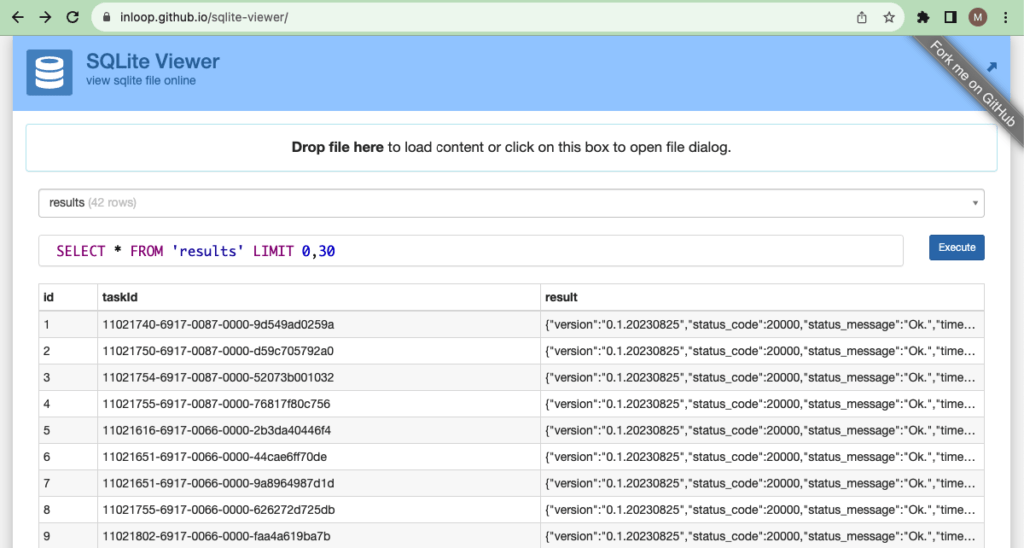intro
SQLite, an integral SQL database engine for numerous applications, necessitates effective database interaction and management tools. This is where SQLite viewers come in. In this article we'll have a look at different SQLite viewers and go through some pros and cons of each.
What Is an SQLite Viewer?
An SQLite viewer is software enabling users to access and manage SQLite databases, offering features like viewing tables, running SQL queries, and data editing. Below is an example of a browser-based SQLite viewer we like.

How to Use an SQLite Viewer
Utilizing an SQLite viewer involves several key steps:
- Opening the viewer: The user interface of SQLite data exploration tools typically provides a menu or a direct option to open or create a database.
- Connecting to a database: Connect to an existing SQLite database by selecting the database file. In web-based viewers, this might involve uploading a file, while desktop applications would require navigating to the file location.
- Browsing and editing data: Once connected, you can browse through tables and records. Viewers typically present data in a tabular format, allowing for easy viewing and inline editing. This step is crucial for examining and modifying data as needed.
- Executing queries: Advanced users can execute SQL queries to manipulate data, create new tables, or run complex searches. This feature is vital for custom data manipulation and analysis.
- Saving changes: After making changes or updates, it’s important to save them. In read-only modes, this might not be applicable. For editable viewers, ensure to commit the changes to the database.
Limitations of an SQLite Viewer
SQLite viewers are great tools, but they come with some constraints:
- Read-only modes: Some viewers, especially web-based ones, operate in a read-only mode, restricting the ability to edit or modify data.
- File size limits: Large SQLite databases might pose a challenge, as certain viewers have limitations on the maximum file size they can efficiently handle.
- Handling corrupted files: Viewers typically require well-maintained, uncorrupted database files. Files with missing components, such as journal files, may not be supported.
- Platform dependencies: While many viewers aim to be platform-independent, some might have specific requirements or perform better on certain operating systems.
- Feature limitations: Not all viewers offer comprehensive features like advanced query building or data visualization, which might be necessary for complex database analysis.
Recommended SQLite Viewers
Let's look at three different approaches to SQLite data visualization.
Browser-Based SQLite Viewer Web Apps

A web-based tool offers a convenient and user-friendly platform for quick SQLite file inspection. InLoopX’s SQLite viewer is particularly notable for maintaining data privacy, as all operations are processed client-side.
👍 Pros:
- Free
- Platform-independent
- Privacy-focused
👎 Cons:
- Read-only
- Limitations with large files
🎯 Target Users: Ideal for users needing quick, basic SQLite file inspections focusing on data privacy.
Proper SQL Clients

There are also proper SQL Clients out there that will do the job even better, but they require you to download and install them. DbVisualizer is an example of this, and we love it because it has a free version, supports a wide range of databases, including SQLite, and can handle almost anything you throw at it. It connects easily to your SQLite database and gives you full control to both view and edit the database. It can even generate a Relationship Diagram for you automatically, which is a great way of getting an overview of the tables and their relationships. While it does the basics very well, it is also equipped with advanced features, so it will grow with you as your needs become more complex or when you find yourself needing to manage a non-SQLite database.
👍 Pros:
- Free option available and simple to get started
- Supports various SQL databases
- Very capable with a rich feature set
👎 Cons:
- Can be complex for beginners
- The number of features can make the UI seem a bit overwhelming
🎯 Target Users: Suited for professionals and users requiring extensive database management features.
Built-in OS Programs (e.g., macOS's Terminal)

These SQLite viewer tools are integrated with the operating system. In detail, they provide command-line interfaces for SQLite database interaction. These applications are particularly useful for users familiar with command-line operations, offering direct and powerful database management.
👍 Pros:
- Native OS integration
- Powerful for experienced users
👎 Cons:
- Not beginner-friendly
🎯 Target Users: Best for users skilled in command-line operations.
Conclusion
In summary, SQLite viewers are great tools for anyone dealing with SQLite databases, offering functionalities ranging from basic data inspection to comprehensive database management.
Understanding how to use these viewers, recognizing their limitations, and choosing the right tool based on specific needs can significantly enhance database handling efficiency. Whether you're a novice requiring a simple, browser-based viewer or a professional in need of an advanced SQL client, there's an SQLite viewer available to meet your requirements.
Our personal recommendation goes to InLoopX’s SQLite viewer for those who just want to see the contents of their SQLite database quickly. If you, on the other hand, want some more capabilities like editing, saving of queries, ERD visualization etc, our top SQLite Client is DbVisualizer. It is really hard to recommend the Terminal to most people to see the contents of their SQLite databases, but if that is what you are all about, that’s fine too.
Embracing these tools will undoubtedly streamline your data management tasks and unlock new potentials in database administration and analysis for you.
FAQs
Can SQLite data visualization tools edit data?
Yes, but some may have read-only limitations. If you want to be able to edit the data, we recommend using DbVisualizer.
Are SQLite viewers secure?
Generally yes. If you are using downloaded software, like DbVisualizer, you are totally safe. If you are using browser-based SQLite viewers, you should choose those that process data client-side.
Can SQLite viewers handle large databases?
This varies based on the viewer's file size capabilities. In most cases, you will find that locally installed SQLite viewers, like DbVisualizer, are much more stable with large databases than browser-based SQLite Viewers.


